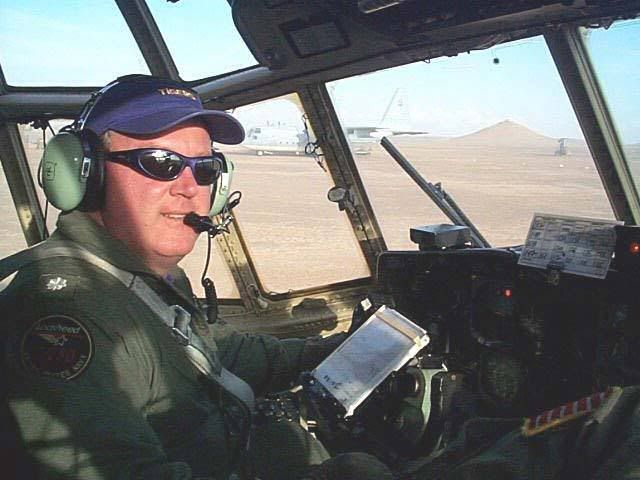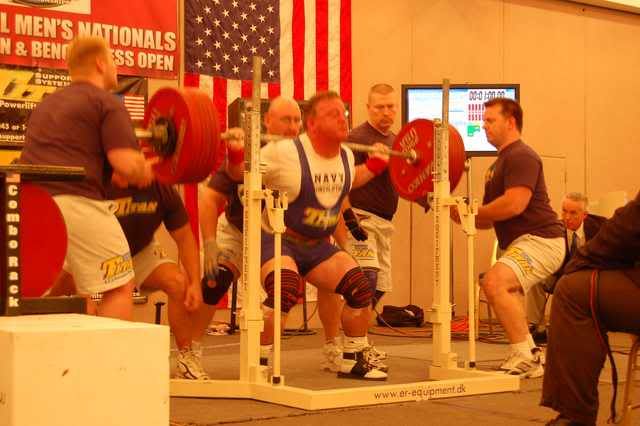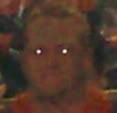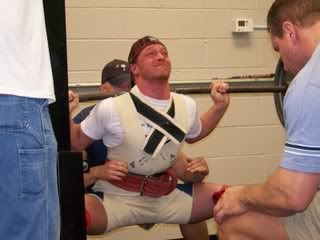Post by maxson on Jan 21, 2007 10:29:19 GMT -5
By Steve Maxson
For NC APF

SM: Tell us a little about yourself.
JR: I am 45, married with kids, and am a career Navy Pilot. I am a graduate of the US Naval Academy with a BS in Operations Analysis. We currently live in a suburb of New Orleans. Powerlifting is my hobby/obsession depending on who you ask.
SM: How long have you been competing?
JR: My first competition was my sophomore year in HS, in an Olympic Meet as a 132 lber. I quickly figured that the lack of a coach was going to be a problem. I found a Coach named Glenn Riebman who was the S+C Coach at Lafayette College in Easton, Pa. Glen was a powerlifter and took me under his wing. I competed in HS and College at 148-181, then took a few years off until I was about 30. Did a few meets at 198, then up to 220, and finally 242.


Jack in the 80's
SM: What are your best lifts?
JR: 722 squat, 575 BP, and 623 deadlift at 242. I lift in the USAPL mainly but started in the AAU, switched to USPF and ADFPA, but happy to go anywhere to compete, especially if it is close to home. I have only used single ply gear for now but who knows…
SM: What are your short and long term goals?
JR: My short term goal is to drop back to 220 and try to maintain my strength and hit Elite. My main reason for going 242 was that the USAPL normally has two hour weigh ins. Holding my weight up around 240 was becoming a pain. My long term goal is to BP 600 in a single ply and then figure out what is next. Maybe try some better gear.
SM: Besides your best lifts what are some of your career highlights in the sport?
JR: Far and away the biggest thrill I have ever had in the sport was lifting in the USAPL Nationals. I had qualified by winning the Military Nationals a few times but never made the qualifying total. In 2003 I made the total right before deploying for OIF and then came in 8 th in Baton Rouge that summer. Last year I was separated from my family after Hurricane Katrina when they went to live with my wife’s family in Miami, and the Navy moved me to Memphis temporarily. When I saw the USAPL Nationals were going to be in Miami, I made my focus getting back to lift on a National platform in front of my kids. Not a great day, but I moved up to fourth and more importantly my kids got to see me compete. I can’t underplay 3 Military National Titles but besides Miami, lifting in Reed Bueche’s “Biggest Bench on The River” is amazing. A huge insane crowd, great lifters, and a beautiful place just a bit North of Baton Rouge. I highly recommend it. Reed is a great guy, meet director, and an amazing announcer. After I hit a 575BP at his meet, he demanded I take a fourth attempt at 600. I went hoping for 575, but left convinced 600, which I missed by a hair, is going to happen.

Jack in Miami
SM: Tell us a little about your diet and supplementation.
JR: At 242 I eat a lot and an occasional malted beverage or dessert. I eat pretty clean otherwise but have to work at keeping the weight up. I went on a cruise ship once for a week and lost 7lbs! I have a fast metabolism! I avoid most fried food and as much processed food as possible, but otherwise eat 3-4 meals a day minimum and about 150-200 grams of protein a day. I don’t sweat diet. Dropping to 220 I just eat less carbs and no Malted beverages or dessert. I use creatine, whey, Essential Fatty Aids, a multi, and Gluco/chondroitin.
SM: You have a unique style that is detailed in an article you wrote for Elite Fitness called "Somewhere Between Moscow and Columbus” (see link below). Have you made any recent modifications to this training program and if so why?
JR: My biggest change is to add some sets of medium heavy squats in loose gear on Repetitive Effort Day. If you look at Brian Schwab and Matt Kroczaleski squatting on Elitefts workout logs, they work up to a top set adding gear as they go in the squat. As my bodyweight drops my old squat suit is getting loose enough to get 585 to USAPL depth, where at 240 it takes 670. So I will throw in some doubles below 605 or so in loose gear to end RE day. I have also added back in band work at the top end to deal with my lockout issues in the BP as assistance on RE BP day.
SM: Reading your training log on T-Nation (see link below) I noticed that you typically work with two bench shirts, a loose shirt and then a tight shirt. I also noticed that you will change shirts during a meet. It can take time to get comfortable in a shirt, why not just train and compete in one shirt?
JR: I learned changing shirts in a meet from my old Training Partner and WPO Bencher James Burdette. He knows exactly what touches in each of his shirts at meet and training bodyweights because he practices in his shirts and knows them perfectly. If you practice, you can swap shirts even in a REALLY fast meet like the USAPL Nationals. At 242 it takes 523 to touch in my 48 F6, and 551 to touch in my 46 F6. I dumped 551 in my 48 Katana my last meet so I am guessing that is a 562 shirt, at 242. I will have to dial in my shirts again at 220. Louie Simmons suggested using a loose shirt in my workout rotation. I have a really old 52 F6. It goes on almost without help, and if I leave it high I can touch 405 in the shirt. I can jack it enough to make 475 hard to touch. Great work for speed or lockout depending on how I tweak the shirt, and really teaches you how to adjust your shirt. Louie has also written that your squat suit should take your opener to get to depth, and I use that approach in my BP shirt too. I like to use a looser shirt so I can open lighter. Lots of folks open too high and bomb. You have to find a comfortable approach.
SM: You also do a lot of kettlebell work, sled dragging, mobility work and extra workouts. How has the extra GPP and mobility work benefited your training?
JR: Hugely. Mobility IS the way to warm up ahead of Training and to help recovery afterwards. I also like the book “Yoga for Regular Guys” by Diamond Dallas Page, and the Videos “Strength Stretching” by Pavel Tsatsouline and “Magnificient Mobility” by Eric Cressey and Mike Robertson. GPP and SPP are an enormous part of recovery when you are relying only on Creatine and Creole chicken as your strongest supplements. I do 5-6 extra workouts every week along with my four gym workouts.

SM: It can be a real challenge to put 100% into powerlifting with other obligations such as family, work, travel etc. How do you adapt to the additional challenges associated with being a Navy pilot?
JR: I just press on and train. With the exception of the last one or two geared Max Effort days before a meet, no one workout is critically important. For example, this week on Monday I want to Bench in my loose shirt and Friday I want to use my good squat suit. Monday we have to go to a High School Orientation and Thursday and Friday I am flying. So Monday I will bench at work raw and do some board work and will slide Friday’s squats to Saturday. I will also get up EARLY Thursday and get my speed BP in before brief time. I have had to cancel a few meets due to Operational Requirements, but I have also missed meets due to injury or the meet director canceling. I almost never miss a workout, I just slide them or adjust them. Just keep on training and find the next meet. Being Military is an overall advantage! Almost always a great gym or two no matter where you go in the world, time built into the day to workout, and lots of folks compete at something, from marathons or Triathlons to Golf to extreme Racing. Running a mile and half twice a year is no fun, but flying is a great way to get paid for doing what you would do for free! I like my job! Only getting on the platform comes close to flying at night in harms way.
SM: What is your advice to a beginner?
JR: Find a knowledgeable Coach or group of Powerlifters to train with and teach you the lifts. Learn to box squat, board press, and deadlift in the style you don’t normally use as your main assistance. Don’t be afraid to move up a weight class every few years. Moving up will help your BP and SQ, and when your DL stops going up you need to stay put! Keep the reps 5 or lower for the Powerlifts. Learn all you can from every available source. Slowly add gear.
SM: Jack, Thank you for your time and your service to our country and good luck on your quest for Elite. Please feel free to provide any final comments.
JR: Do not put limits on yourself! Find a coach, pick an approach, then get to work. Do a meet in your first year and be prepared for a huge learning experience. Then enjoy the ride!
Jack's Training Log on T-Nation:
www.t-nation.com/readTopic.do;jsessionid=6B57702583C9F73DAE4DA6CAF74797CA.hydra?id=1245783
Articles by Jack Reape:
www.elitefts.com/documents/moscow_and_columbus.htm
www.elitefts.com/documents/going_deeper.htm
www.t-nation.com/findArticle.do?article=05-010-training
www.t-nation.com/readTopic.do?id=1247464
www.t-nation.com/findArticle.do?article=05-074-training
www.t-nation.com/findArticle.do?article=05-093-training
Feel free to ask Jack any questions.
For NC APF

SM: Tell us a little about yourself.
JR: I am 45, married with kids, and am a career Navy Pilot. I am a graduate of the US Naval Academy with a BS in Operations Analysis. We currently live in a suburb of New Orleans. Powerlifting is my hobby/obsession depending on who you ask.
SM: How long have you been competing?
JR: My first competition was my sophomore year in HS, in an Olympic Meet as a 132 lber. I quickly figured that the lack of a coach was going to be a problem. I found a Coach named Glenn Riebman who was the S+C Coach at Lafayette College in Easton, Pa. Glen was a powerlifter and took me under his wing. I competed in HS and College at 148-181, then took a few years off until I was about 30. Did a few meets at 198, then up to 220, and finally 242.


Jack in the 80's
SM: What are your best lifts?
JR: 722 squat, 575 BP, and 623 deadlift at 242. I lift in the USAPL mainly but started in the AAU, switched to USPF and ADFPA, but happy to go anywhere to compete, especially if it is close to home. I have only used single ply gear for now but who knows…
SM: What are your short and long term goals?
JR: My short term goal is to drop back to 220 and try to maintain my strength and hit Elite. My main reason for going 242 was that the USAPL normally has two hour weigh ins. Holding my weight up around 240 was becoming a pain. My long term goal is to BP 600 in a single ply and then figure out what is next. Maybe try some better gear.
SM: Besides your best lifts what are some of your career highlights in the sport?
JR: Far and away the biggest thrill I have ever had in the sport was lifting in the USAPL Nationals. I had qualified by winning the Military Nationals a few times but never made the qualifying total. In 2003 I made the total right before deploying for OIF and then came in 8 th in Baton Rouge that summer. Last year I was separated from my family after Hurricane Katrina when they went to live with my wife’s family in Miami, and the Navy moved me to Memphis temporarily. When I saw the USAPL Nationals were going to be in Miami, I made my focus getting back to lift on a National platform in front of my kids. Not a great day, but I moved up to fourth and more importantly my kids got to see me compete. I can’t underplay 3 Military National Titles but besides Miami, lifting in Reed Bueche’s “Biggest Bench on The River” is amazing. A huge insane crowd, great lifters, and a beautiful place just a bit North of Baton Rouge. I highly recommend it. Reed is a great guy, meet director, and an amazing announcer. After I hit a 575BP at his meet, he demanded I take a fourth attempt at 600. I went hoping for 575, but left convinced 600, which I missed by a hair, is going to happen.

Jack in Miami
SM: Tell us a little about your diet and supplementation.
JR: At 242 I eat a lot and an occasional malted beverage or dessert. I eat pretty clean otherwise but have to work at keeping the weight up. I went on a cruise ship once for a week and lost 7lbs! I have a fast metabolism! I avoid most fried food and as much processed food as possible, but otherwise eat 3-4 meals a day minimum and about 150-200 grams of protein a day. I don’t sweat diet. Dropping to 220 I just eat less carbs and no Malted beverages or dessert. I use creatine, whey, Essential Fatty Aids, a multi, and Gluco/chondroitin.
SM: You have a unique style that is detailed in an article you wrote for Elite Fitness called "Somewhere Between Moscow and Columbus” (see link below). Have you made any recent modifications to this training program and if so why?
JR: My biggest change is to add some sets of medium heavy squats in loose gear on Repetitive Effort Day. If you look at Brian Schwab and Matt Kroczaleski squatting on Elitefts workout logs, they work up to a top set adding gear as they go in the squat. As my bodyweight drops my old squat suit is getting loose enough to get 585 to USAPL depth, where at 240 it takes 670. So I will throw in some doubles below 605 or so in loose gear to end RE day. I have also added back in band work at the top end to deal with my lockout issues in the BP as assistance on RE BP day.
SM: Reading your training log on T-Nation (see link below) I noticed that you typically work with two bench shirts, a loose shirt and then a tight shirt. I also noticed that you will change shirts during a meet. It can take time to get comfortable in a shirt, why not just train and compete in one shirt?
JR: I learned changing shirts in a meet from my old Training Partner and WPO Bencher James Burdette. He knows exactly what touches in each of his shirts at meet and training bodyweights because he practices in his shirts and knows them perfectly. If you practice, you can swap shirts even in a REALLY fast meet like the USAPL Nationals. At 242 it takes 523 to touch in my 48 F6, and 551 to touch in my 46 F6. I dumped 551 in my 48 Katana my last meet so I am guessing that is a 562 shirt, at 242. I will have to dial in my shirts again at 220. Louie Simmons suggested using a loose shirt in my workout rotation. I have a really old 52 F6. It goes on almost without help, and if I leave it high I can touch 405 in the shirt. I can jack it enough to make 475 hard to touch. Great work for speed or lockout depending on how I tweak the shirt, and really teaches you how to adjust your shirt. Louie has also written that your squat suit should take your opener to get to depth, and I use that approach in my BP shirt too. I like to use a looser shirt so I can open lighter. Lots of folks open too high and bomb. You have to find a comfortable approach.
SM: You also do a lot of kettlebell work, sled dragging, mobility work and extra workouts. How has the extra GPP and mobility work benefited your training?
JR: Hugely. Mobility IS the way to warm up ahead of Training and to help recovery afterwards. I also like the book “Yoga for Regular Guys” by Diamond Dallas Page, and the Videos “Strength Stretching” by Pavel Tsatsouline and “Magnificient Mobility” by Eric Cressey and Mike Robertson. GPP and SPP are an enormous part of recovery when you are relying only on Creatine and Creole chicken as your strongest supplements. I do 5-6 extra workouts every week along with my four gym workouts.

SM: It can be a real challenge to put 100% into powerlifting with other obligations such as family, work, travel etc. How do you adapt to the additional challenges associated with being a Navy pilot?
JR: I just press on and train. With the exception of the last one or two geared Max Effort days before a meet, no one workout is critically important. For example, this week on Monday I want to Bench in my loose shirt and Friday I want to use my good squat suit. Monday we have to go to a High School Orientation and Thursday and Friday I am flying. So Monday I will bench at work raw and do some board work and will slide Friday’s squats to Saturday. I will also get up EARLY Thursday and get my speed BP in before brief time. I have had to cancel a few meets due to Operational Requirements, but I have also missed meets due to injury or the meet director canceling. I almost never miss a workout, I just slide them or adjust them. Just keep on training and find the next meet. Being Military is an overall advantage! Almost always a great gym or two no matter where you go in the world, time built into the day to workout, and lots of folks compete at something, from marathons or Triathlons to Golf to extreme Racing. Running a mile and half twice a year is no fun, but flying is a great way to get paid for doing what you would do for free! I like my job! Only getting on the platform comes close to flying at night in harms way.
SM: What is your advice to a beginner?
JR: Find a knowledgeable Coach or group of Powerlifters to train with and teach you the lifts. Learn to box squat, board press, and deadlift in the style you don’t normally use as your main assistance. Don’t be afraid to move up a weight class every few years. Moving up will help your BP and SQ, and when your DL stops going up you need to stay put! Keep the reps 5 or lower for the Powerlifts. Learn all you can from every available source. Slowly add gear.
SM: Jack, Thank you for your time and your service to our country and good luck on your quest for Elite. Please feel free to provide any final comments.
JR: Do not put limits on yourself! Find a coach, pick an approach, then get to work. Do a meet in your first year and be prepared for a huge learning experience. Then enjoy the ride!
Jack's Training Log on T-Nation:
www.t-nation.com/readTopic.do;jsessionid=6B57702583C9F73DAE4DA6CAF74797CA.hydra?id=1245783
Articles by Jack Reape:
www.elitefts.com/documents/moscow_and_columbus.htm
www.elitefts.com/documents/going_deeper.htm
www.t-nation.com/findArticle.do?article=05-010-training
www.t-nation.com/readTopic.do?id=1247464
www.t-nation.com/findArticle.do?article=05-074-training
www.t-nation.com/findArticle.do?article=05-093-training
Feel free to ask Jack any questions.



